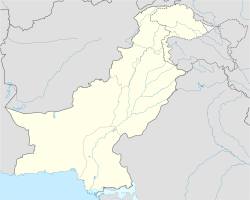world.wikisort.org - Pakistan
Hadali (Urdu: ہڈالی) is a town located in Khushab District in the Punjab Province of Pakistan. The town is administratively subdivided into two Union Councils, including Hadali-Ii.[2][3]
This article needs additional citations for verification. (January 2015) |
Hadali | |
|---|---|
 Location in Pakistan | |
| Coordinates: 32°17′32″N 72°11′32″E | |
| Country | Pakistan |
| Province | Punjab |
| Elevation | 188 m (617 ft) |
| Population (2010) | 57,351[1] |
History
Khushab District was a forested agricultural region during the Indus Valley civilization. The Vedic period was characterized by Indo-Aryan culture that invaded from Central Asia and settled in the Punjab region. The Kambojas, Daradas, Kaikayas, Madras, Pauravas, Yaudheyas, Malavas, and Kurus invaded, settled and ruled the ancient Punjab region.
After overrunning the Achaemenid Empire in 331 BCE, Alexander the Great marched into the Punjab region with an army of 50,000. The Khushab region was ruled by Maurya Empire, Indo-Greek kingdom, Kushan Empire, Gupta Empire, White Huns, Kushano-Hephthalites and the Turk and Hindu Shahi kingdoms.
In 997 CE, Sultan Mahmud Ghaznavi, took over the Ghaznavid dynasty empire established by his father, Sultan Sebuktegin. In 1005, he conquered the Shahis in Kabul in 1005, and followed it by the conquests of the Punjab region. The Delhi Sultanate and, later, the Mughal Empire ruled the region. The Punjab region became predominantly Muslim due to missionary Sufi saints whose dargahs dot the landscape.
After the decline of the Mughal Empire, the Sikh Empire invaded and occupied the Khushab District. During the period of British rule, Khushab district increased in population and importance.
The predominantly Muslim population of Khushab District supported the Muslim League and Pakistan movement. After independence in 1947, the minority Hindus and Sikhs migrated to India while the Muslim refugees, Rajputs, from India settled in the Hadali after Partition of India and Pakistan in 1947. Muslim Rajputs who migrated to India settled in the Hadali.
Economy
Hadali's main source of income is agriculture. The main crops farmed in Hadali are sugarcane, gram (a type of pulse), wheat and rice.[4]
The practice of cattle-farming also contributes to the economy in Hadali.[citation needed]
Public figures
This section may contain indiscriminate, excessive, or irrelevant examples. (March 2021) |
- Malik Charagh Bali (Late)
- Malik Zafar Ullah Khan Bali S/o (Late) Charagh Bali.
- Muhammad Salman Ahmed Bali
- Haji (Late) Master Mehar Ali Bali (Anjaman Islah-ul-Musalmeen)
- Muhammad Akhtar Islam Bali Advocate (Ex-Nazim Hadali)
- Malik Muhammad Nawaz Wadhal Tiwana Former Chairman P.I.A / Chairman Steel Mill Karachi Singh.
- Malik Abdul Majeed Mastial Tiwana (late) Justice retired High Court.
- Miss Nilofar Bakhtiar (Chairperson of the National Commission on the Status of Women (NCSW))(Former Federal Minister for Tourism of Pakistan)[5][circular reference]
- Malik Rabnawaz Wadhal(Late)
- Malik Haqnawaz Wadhal Former I.G(Late)
- Malik Saifullah Khan Wadhal(Late)
- Malik Khuda Baksh Wadhal Tiwana (MPA and Chairman)
- Malik Hamid Mehmood Wdhal(Chairman MC Hadali)
- Malik Muhammad Azam Tiwana Shaheed
- Major (late) Malik Allah Bakhsh Tiwana (Mastial)
- Numbardar (late) Malik Muhammad Khan Mastial Tiwana
- Malik Abdullah Khan Virk S/O Late Malik Walli Khan Virk
- Maulana Zafar Ali (Late) Bhaseen
- Maulana Muhammad Ayoub Chishti
- Major Ahmad Khan Wadhal Tiwana Shaheed E kargil
- Malik Muhammad Naeem Ullah Wadal (Late).
- Malik Mazhar Anwar Wadal (Late)
- Risaldar Malik Chohar Khan Bhaseen(Late)
- Malik Muhammad Tahir Awan.
- Malik Waqas Khan Virk.
- Major Malik Fateh Khan Virk(Late)
- Mufti Muhammad Nasir Chaweka.
- Dr Malik Majeed Tiwana
Notable people
- Khushwant Singh was an Indian Sikh journalist and novelist born in 1915 Hadali. Some of his ashes were scattered in Hadali.[6]
- Brigadier (R) Rashid Ali Malik (1.Sitara-e-Imtiaz , 2.Tamgha-e-Basalat)[7][circular reference]
References
- Word Gazetteer.
- Local Government Elections – Government of Pakistan Archived 2008-01-24 at the Wayback Machine
- Location of Hadali – Falling Rain Genomics
- "Natural Resources | Punjab Portal". www.punjab.gov.pk. Retrieved 2020-03-03.
- "Nilofar Bakhtiar".
- Fistful of Khushwant’s ashes saved for Pakistan
- "Rashid Ali Malik".
External links
- Hadali on Facebook
- "Natural Resources | Punjab Portal". www.punjab.gov.pk. Retrieved 2020-03-03.
Другой контент может иметь иную лицензию. Перед использованием материалов сайта WikiSort.org внимательно изучите правила лицензирования конкретных элементов наполнения сайта.
WikiSort.org - проект по пересортировке и дополнению контента Википедии